Religion of Time and watch idols
With the current of the river Time: to override the unknown
The ability to navigate in time is one of the most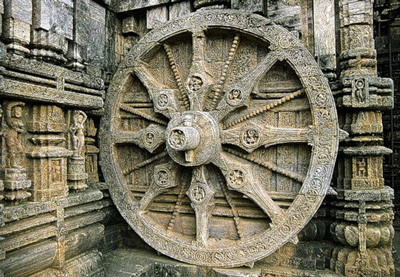 unique human abilities, and although this statement is rather relative (judging at the universal scale), we have still created an ordered system of orientation in time... unique human abilities, and although this statement is rather relative (judging at the universal scale), we have still created an ordered system of orientation in time...
Ever since the ancient times, people had been trying to organize an incomprehensible value by countable units that would have been accessible and understandable to them. And the man became the creator of the most original illusion of control over the Time - the wrist watch. In this small movement, which is placed on the wrist, the seconds, minutes and hours are subject to and controlled by him, at least in the system, which he created by himself for orientation in space. Throughout all human existence the "relations" with the Time have become one of the most unnoticeable, but ever-presenting constants in our lives, which has turned into one of the most influential areas of industrial production over the past two centuries.
And so it has become a tradition since ancient times that mankind always created various "traps" for the Time. Different nationalities "caught" the Time in different ways. For example, the ancient Chinese measured out time intervals by an oiled rope with evenly distributed knots. The rope was set on fire, and the number of burned units determined time periods. To measure the time, except common methods, they also used oil lamps, wicks, divided candles and much more that the history has not preserved for us.
One of the most common methods and better way of determining the time was the sundial, representing a dial, located on a flat surface with twelve divisions corresponding to the twelve zodiac signs and located on the edges and a vertical rod in the center. The shadow arising from the rod, after the sun moving across the sky, moved at the surface of the dial, thus indicating the exact time.
There were even certain positions, which proved how important the time was for the people. For example, in ancient Rome there was a special position - "keeper of hours," who had to inform his owner of each hour.
 In addition to this kind of static and fixed clocks, there were, if I may say so, "models" designed for travelers. Those "clocks" represented sticks with markings, at the handle of which there was a hole, into which a special rod was inserted. It cast a shadow over the markings of the stick, thus indicating the time. Such "clocks" were mainly used by travelers, pilgrims and shepherds, as well as military leaders. However, the biggest drawback of those clocks was absolute inaction at the night time. In addition to this kind of static and fixed clocks, there were, if I may say so, "models" designed for travelers. Those "clocks" represented sticks with markings, at the handle of which there was a hole, into which a special rod was inserted. It cast a shadow over the markings of the stick, thus indicating the time. Such "clocks" were mainly used by travelers, pilgrims and shepherds, as well as military leaders. However, the biggest drawback of those clocks was absolute inaction at the night time.
In addition to the sundial, as history shows, there was also a water clock, which was mainly popular in India, Egypt, Greece, China, and was able to show the time at day and night. The water clock represented a glass bowl with markings applied on the walls, where the water from a reservoir was supplied by drops. Evenness of drops, in its turn, was provided by constancy of the water in the filled tank.
In addition to the sun and water, the time could be identified also by sand-glass - the oldest clock in the world. We all know what it is, but the metamorphoses that took place with the sand-glass over the time are more interesting.
Thus, in the Middle Ages a special dial was attached to the sand-glass. A special superintendent was appointed to watch that clock, turn it over and manually transfer the hand on the dial as soon as the sand flew from one vessel to another. They say that such clock was a precursor of the modern pocket watch, because at that time there were eccentrics, who attached sand-glasses to their feet to inquire about the time whenever they wanted.
The Middle Ages and subsequent periods became one of the most tumultuous periods in the development of clocks and watches. The first mechanical clock, presented in Milan in 1335, was created. After the first technical break a dynamic era of unceasing progress and development of clocks, becoming an increasingly indispensable tool in human life, starts. An invention by Dutch scientist Huygens becomes another breakthrough in watchmaking: in 1675, the scientist uses a pendulum to control the accuracy of clock for the first time. And until the mid-20th century clocks underwent serious improvements. The watches, as they are now, are born in the early 20th century, specially for aviators. The world wars, various moods of famous people, as well as continued development of scientific and research areas that needed accurate indexing of time were the main reasons.
A lot of watch companies, which left their unique marks in the history of watchmaking, embodying the ancient human desire to override sometimes sedate and sometimes violent and unpredictable current of the river called the Time, were born. Another milestone in the history of the wristwatch is the era of electric watches in the early 1950s, then in 1967 quartz watches appeared , and in 1972 - digital watches.
***.jpg)
The modern concept of "watch" includes not only a time meter, but also a small "encyclopedia" of its owner, which can tell a lot about him, however, only to the initiated into this magical world of gears, wheels, hands and numerals.
Today it is difficult to say, who invented the first wristwatch. The history has left us a lot of controversial options that are individually plausible and supported by historical facts ... The right of the invention of the first wristwatch is contested by two major watch companies - Patek Philippe and Breguet. Thus, according to Patek Philippe, the first wrist watch was made by them for the Hungarian countess Koscowicz in 1868. But the chronicle of the company “Breguet” points the Napoleonic era, when by a special order the company was made a women’s wrist watch as a gift to Caroline Murat – Napoleon’s sister. As for men's watches, they were created by Cartier, which became the initiator of mass production of men's watches. The author of the idea was aviator Santos-Dumont, a close friend of Cartier ...
For two hundred years of existence, watches have become something more than just devices of practical application. Watches are an embodiment of ancient human instinct of worshiping the unknown – what evokes sacred fear and admiration and overwhelming sense of belonging at the same time. They are a special space where people, cultivating objects of their worship, create beautiful products on the brink of their abilities, expressing their respect to the enormous and universal river called the Time...
The Cult: admiration and worship
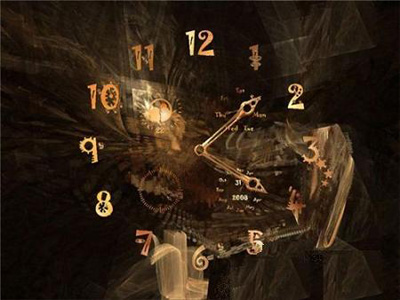 Where does the river of time flow? Let's fantasize about it. One can imagine a direct channel of the Time river, flowing in a certain direction, or suggest that the river of Time is infinite and flows into nowhere, and therefore has no end. Some of us are convinced that the Time, as the course of history, is directed down the slope, and its inevitable end is in the abyss. This version has its own scientific evidence - "entropy" - a process that eventually leads to disintegration of everything into original elements in a state of absolute stillness and without any interaction (in Norse mythology, for example, such a tragic end is called "twilight of the gods"). And others offer an idea of infinite and forward movement, called "progress", according to which the river of Time flows upwards. Where does the river of time flow? Let's fantasize about it. One can imagine a direct channel of the Time river, flowing in a certain direction, or suggest that the river of Time is infinite and flows into nowhere, and therefore has no end. Some of us are convinced that the Time, as the course of history, is directed down the slope, and its inevitable end is in the abyss. This version has its own scientific evidence - "entropy" - a process that eventually leads to disintegration of everything into original elements in a state of absolute stillness and without any interaction (in Norse mythology, for example, such a tragic end is called "twilight of the gods"). And others offer an idea of infinite and forward movement, called "progress", according to which the river of Time flows upwards.
During its existence, at different times people created a culture that reflected their vision and aspirations, fears of unexplained phenomena, and, of course, magnified the objects of their worship. In works of art people were trying to express their deepest desire to own the Time in the most literal sense of the word.
Remember the movie "The Curious Case of Benjamin Button", where the Time moves in the opposite direction? In this unusual film everything depends on the second hand, which is endowed with a fantastic ability to change a person's age, moving backward.
Physicists often note one of the unique properties of Time: while in a space, which we usually associate with the concept of Time, one can move freely in any direction, such movements in the Time are impossible. In relation to the Time we are static, and indeed, the Time, like a river, flows around us, moving in one direction, which no one has the power to change. We have no control over it, and we can only watch, measure, and worship that we are unable to comprehend.
***
Notions of Time have been different during the existence of man. Each science represented it on its own way, every scientist and philosopher offered a new interpretation. Well, it is man’s nature to worship what he admires, fears and, of course, what he glorifies and gives supernatural powers.
However, today we will not talk about how to control its majesty of Time, or how to manage, or, even more, how to worship it. Rather we'll talk about what is not clear to the man, causing incredible admiration and fear of the unknown, feeling of worship ...
Can we say that the man worships the Time? That the Time has become a cult for a person? This is, of course, a disputable issue, the answer on which depends on our point of view.
Basically the concept of cult is attributed to the worship of anyone or anything. An encyclopedia, for example, defining the meaning of the word “cult”, marks its Latin origin.
The word “cult” comes from the Latin “colo” - esteem. Its basic meaning in our usual comprehension is religious. Religious worship of certain items, fantastic or real beings, endowed with supernatural properties, raises an object of worship into the category of cult. If we define the cult in a wide sense, then it is rather a historical type of relationships, the constituent elements of which may be religious and magical practices (prayers and rituals), and related objects (temples, sacred images, etc.). These external symbolic acts and materials of cult, which represent a peculiar system of "cult objects", are inextricably connected with various systems of religious beliefs, feelings, and corresponding social roles and relationships (priesthood, church organization, etc.). In a more narrow sense, the word “cult” means religious relationships that concern faith and worship of supernatural beings (in such concept the cult does not include magical rites and rituals of spirits spell).
Whatever it was, speaking about cult, we will have in mind any type of religious worship. Historical forms of religion are characterized by specific cult complexes, such as totemic cult, funerary cult, work cult, tribal cult, shaman cult, cult of tribal god, and many others, which became an object of worship throughout its existence.
Direct magical actions, such as gestures of adoration (upraising hands, looking up to the sky, etc.) can be called one of the original forms of cult. There is an assumption that they arose from the first magical gestures. Later this kind of primitive magic dances (hunting, military, etc.) became an integral part of many other religions’ cult.
 The researchers distinguish various cults by the objects of worship: cult of the Sun, cult of animals, cult of sky, cult of water, cult of plants, cult of fire, cult of ancestors, cult of king ... The researchers distinguish various cults by the objects of worship: cult of the Sun, cult of animals, cult of sky, cult of water, cult of plants, cult of fire, cult of ancestors, cult of king ...
The cult of prayer, for example, is one of the most important manifestations of the concept of cult. The researchers of this phenomenon suggest that the cult of prayer evolved from the cult of magical incantations.
One of the major components of each cult and its concept on the whole in human mind is the use of various items, which over the time are also given a "cult" status. This often depends on various circumstances. Thus, in various religious cults one can find cult objects - icons, ecclesiastical vessels, churches, etc.
Experts believe that the use of various objects in religious ceremonies, which are raised into the cult, goes back to the fetishism - primitive times, when people attributed supernatural power to inanimate objects. This trait is expressed especially clearly in Christianity and Buddhism. Thus, a variety of subjects was endowed with a mysterious mystical power, which led to the raise of some items into the category of "cult" in the course of world history. Such items were mainly holy relics, holy water, miracle-working icons, crucifix and various religious relics.
During the existence of mankind, religion had enormous influence on human life and outlook, dividing the history of the world into different times, unleashing wars and leaving behind the objects of worship, which eventually became object of cult. The Shroud of Turin serves such a striking example...
In present the concept of cult has changed somewhat, "worn out" religious plaque a little bit. The cult also penetrated into contemporary art: today many people use the words, such as cult movies, books, and, why not, artists, writers and directors, cars and various luxury items. This proves that in most cases, using this word, we do not think about its ancient and profound sense, or just the word itself has become more "modernized", meaning a new milestone of the area where it is used.
There are a lot of items throughout the mankind history that could be identified in the category of "cult". One can even write a treatise about them in the light of this "cult", features of the history and the era of the appearance and existence of the subject. Whatever it was, the Time and its movement are beyond of our control, and raising objects into a cult is our right, originally condemned by the Bible.
Today, our perception of time is formed by the tools that we use to measure it - watches, as well as by the correlation of our actions with the cycles of time. As for watches that faithfully measure the human time, they haven’t certainly become subjects of religious worship. But for their short 200-year history, many models have become a symbol of the era, historical events, human relationships and destinies, technical accomplishments, and an example of creating unique movements.
Now remember what is considered to be the most expensive thing in today's 21st century? That's right: the Time! Our accelerated pace of life gradually began to cultivate the time, and many thing, concerned it. Is it good or bad – we can’t judge. Our article is devoted to the cult watches - wristwatches, which have become not just unique movements, but watches, which became a symbol of the era and survived it, became a legend, surpassing even their creators with their names...
But let's not get ahead of ourselves, and talk a little about the most interesting cults in the human history, which, in spite of the time, still evoke a sense of awe, and why not, worship...
The cult of the Sun: the worship of light, as a source of vitality
.jpg) The Sun is one of the most ancient symbols of worship for humanity. And how can’t one worship the source of light and life, heralding a new day and good weather? The cult of the Sun is met in almost all cultures of our civilization, and we can say that one the most dark and ignorant people didn’t have it. The Sun is one of the most ancient symbols of worship for humanity. And how can’t one worship the source of light and life, heralding a new day and good weather? The cult of the Sun is met in almost all cultures of our civilization, and we can say that one the most dark and ignorant people didn’t have it.
The Sun, which appeared before any form of life on the Earth, a flow of vital force and its source, was an object of worship for ancient civilizations. Most clearly the cult of the Sun is revealed in ancient Egypt, where the solar deity was correlated with the man, calling him Ra.
However, as the ancient Egyptian’s religion was not monotheistic, the solar deity had a lot of names. The ancient Egyptians connected life and the natural cycles with the motion of the Sun into a logical chain. And, like many nations, the Egyptians considered the East as a birthplace of the Sun, and therefore all movements of the Sun were systematized by the Egyptians in a particular cycle. Thus, the East was the birthplace of the "young" ("Eastern") sun, which was named Gore. After birth the Sun passed its life's way across the sky, where at the zenith it received the name of Ra, traveling, as the Egyptians believed, in the "solar boats." And every evening, the Sun, having made its day trip, "died" in the west. The "old" Sun was called "Atum" by the Egyptians that meant a wise, old and tired deity. Just because the West was considered to be a place of "death" of the Sun, the west coast of the Nile had been serving as a huge cemetery for centuries, where the Egyptians buried their dead.
In accordance with these beliefs, each area of Egypt had its own deity, and each deity had his own "home". The house of the sun god Ra was situated in Heliopolis or, as the Egyptians themselves called that place, “Annu”.
Heliopolis was one of the most important cities of ancient Egypt, located to the north-east of modern Cairo. The modern geography of Heliopolis is a suburb of Cairo called Misr al-Dzhidida that in Arabic means the New Egypt.
There indeed the majestic temple of Ra.jpg) and big house of Atum were erected. They were the reason for the great interest of travelers and pilgrims. However, in the IX century, zealots destroyed the last statues and majestic obelisk, and then in Heliopolis only a sacred spring, where, according to the legend of the Egyptians, the god Ra used to make ablution of his divine face, remained. Up to the present time, the Arabs called that well a "source of the Sun", and according to another legend in that well Jesus Christ’s mother washed the diapers of her son, when escaped from the persecution of Herod at the time of family’s flight from Palestine. and big house of Atum were erected. They were the reason for the great interest of travelers and pilgrims. However, in the IX century, zealots destroyed the last statues and majestic obelisk, and then in Heliopolis only a sacred spring, where, according to the legend of the Egyptians, the god Ra used to make ablution of his divine face, remained. Up to the present time, the Arabs called that well a "source of the Sun", and according to another legend in that well Jesus Christ’s mother washed the diapers of her son, when escaped from the persecution of Herod at the time of family’s flight from Palestine.
The cults of ancient Egypt are ones of the most mysterious and beautiful cultural heritages left to the modern civilization. For the Egyptians Egypt was not just a piece of land, but a reflection of the heavens, or, rather, a reflection of the heavenly waters, which gave birth to all things and even the first ancient god. Heavenly waters, according to the worldview of Egyptians, gathered in the Milky Way, which was reflected on the Earth by the Nile. As the solar deity crossed the Milky Way on his boats, so the Egyptians sent their dead to the last journey across the Nile from East to West.
There were a few symbols of Ra and sun gods of Egypt. However, one of the most important and famous symbols of the Sun deities was a pyramid, as a familiar to us giant tomb, which became one of the brightest examples of cult architecture, so the pyramids of various sizes, which, for example, could be worn as amulets on the belt. As for animate objects of worship, the Phoenix - one of the earthly incarnations of the Sun god, became such a symbol. According to legend, every night Phoenix burnt itself, and as the Sun rose, regenerated from the ashes...
The cult of cat: the worship of beauty and grace
From antiquity to modern jewelry and watches
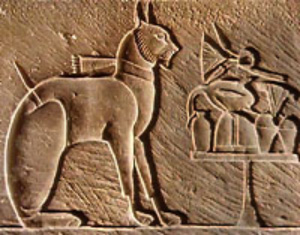 The cat is worshiped in ancient Egypt as nowhere in the world. Studying the first characters that date back to the fifth and sixth dynasties of pharaohs in ancient Egypt, the researchers found out that some of them had been used to write the word “cat”. The characters sound like "miou" or "mint." The cat is worshiped in ancient Egypt as nowhere in the world. Studying the first characters that date back to the fifth and sixth dynasties of pharaohs in ancient Egypt, the researchers found out that some of them had been used to write the word “cat”. The characters sound like "miou" or "mint."
Mythology has given this animal a complex metaphorical meaning, which has been most clearly manifested in Egyptian culture up to the cult of cat, which the Egyptians worshiped.
In the world culture the cult of cat is found in various places. Thus, images of cats were found in the territory of modern Turkey and Jericho, where the pictures found, dating back to the VI-V centuries BC, showed women frolicking with cats. The pictures of cats were found during the excavations of Pompeii died from the eruption of Vesuvius. And also in ancient China, where the cat was worshiped as a sacred animal, more than 1000 years BC. Famous Chinese philosopher and sage Confucius was a great connoisseur and admirer of cats, delighted with the unique ability of cats to get imbued with the mood of its owner. The cat was endowed with features, like goodness, love, joy, motherhood, fertility, and protective force.
Ancient pictures of Egyptian(1).jpg) cats have survived to this day. The Egyptian cult of cat was called Bastet (Bast) after the goddess, embodying the cult. The cult was regarded as a personification of the sun and moon light, and the goddess of cat cult was depicted as a maiden with a cat's head or as a lioness. According to the ancient Egyptians, even the sun god Ra could transform into a giant cat, which won the dragon of gloom and darkness, Apophis. The fight with the dragon is depicted by ancient artists, where the cat bends down the serpent’s head by one pay, and strikes with a knife by another paw. cats have survived to this day. The Egyptian cult of cat was called Bastet (Bast) after the goddess, embodying the cult. The cult was regarded as a personification of the sun and moon light, and the goddess of cat cult was depicted as a maiden with a cat's head or as a lioness. According to the ancient Egyptians, even the sun god Ra could transform into a giant cat, which won the dragon of gloom and darkness, Apophis. The fight with the dragon is depicted by ancient artists, where the cat bends down the serpent’s head by one pay, and strikes with a knife by another paw.
Anyway, the most popular cult of cat was in Egypt. Bubastis, where, according to Greek historian Herodotus, one of the most beautiful temples of Egypt, devoted to the goddess-cat – Bastet, was considered to be a center of worship of cat. The statue of goddess rose in the main sanctuary of the temple. It was depicted as a woman with cat’s head, and on the banks of the great Nile river in ancient times there was no goddess, who would have surpassed the goddess Bastet in greatness and power, embodying femininity, joy, happiness, health, vitality and vision. In honor of the goddess they annually organized celebrations, accompanied by dances and songs. The triumph was held every spring and accompanied by a solemn ritual carrying-out of the sacred statues of cats from the temple on a boat along the banks of the sacred Nile.
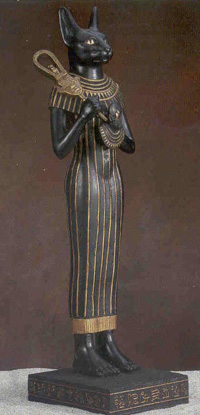 In the temple of Bastet the priests bred sacred cats, feeding them with milk and bread, and fish grown in special containers. Those, who attempted to kill the cat, were punished with all severity: the cats were guarded by law, and if someone dared to raise his hand on them, he was severely punished, even by the death penalty. In the temple of Bastet the priests bred sacred cats, feeding them with milk and bread, and fish grown in special containers. Those, who attempted to kill the cat, were punished with all severity: the cats were guarded by law, and if someone dared to raise his hand on them, he was severely punished, even by the death penalty.
After the death, the owners of mourned their cats as their loved ones. Then they mummified the cat by the same canons as a person, and only after that a funeral ritual was carried. As a sign of mourning the cat owners shaved their eyebrows, and the cat’s body was embalmed. After the mummification, the cat’s body was sewn into a linen shroud, and then put in a sarcophagus and placed into one of many cemeteries that were designed specifically for burying cats and lined up along the banks of the Nile. Thus, the researchers found about tens of thousands of cat mummies, indicating the great respect and popularity of the cult of cat. The goddess Bastet was often compared by the Greek priests with their goddess Artemis, who was considered to be the patroness of fertility and prosperity.
Another feature of cat, for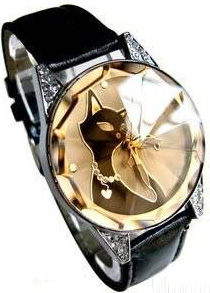 which it was cultured by the Egyptians, is the cat's eye. The fact is that the cat is well-oriented in the dark, and at nights the pupils of cat’s eye take a rounded shape and glow strangely. This metamorphosis led the Egyptians to the conclusion that since the Sun illuminated the ground during the day and the Moon - at night, the Moon was the eye of the Sun at night, and the cat, therefore, from the Egyptian verb "mau" - to see, became a middle honorable link in the Sun-Moon chain as a result of numerous conclusions. which it was cultured by the Egyptians, is the cat's eye. The fact is that the cat is well-oriented in the dark, and at nights the pupils of cat’s eye take a rounded shape and glow strangely. This metamorphosis led the Egyptians to the conclusion that since the Sun illuminated the ground during the day and the Moon - at night, the Moon was the eye of the Sun at night, and the cat, therefore, from the Egyptian verb "mau" - to see, became a middle honorable link in the Sun-Moon chain as a result of numerous conclusions.
One of the most surprising defeats in the Egyptian history is associated with the cult of cats. According to legend, in 525 BC, Persian king Cambyses decided to seize Egypt, but the Persian army was not able to take the city by storm, and Cambyses took the city by stealth. The army would have been left with nothing near the town of Pelusium, if not a brilliant idea of the king: every soldier of the army held a live cat on his breast, and the army marched on the town, protected by living "shields." The Egyptians simply gave up, not daring to hurt or, worse, kill the sacred animals, and the cunning king of Persia conquered Egypt, without spilling a single drop of blood and destroying a single building, and then he founded the 27th dynasty in Egypt.
The cult of cat reaches its apogee during the 12th and 13th dynasties of Egyptian pharaohs, and the temple of the goddess Bastet becomes a place of pilgrimage and worship. Finally, the cult was abandoned in about 390. Since then, the worship and interest in the cats in Egypt gradually come to naught. The cats remain to be pets, but they cease to be an object of worship in temples. So the cult of cat can be called one of the most exciting animal cults of the ancient world...
***
.jpg)
Such admiration for this graceful animal could not find its reflection in the modern world. Up to now we are used be compare the feminine grace with graceful cat. And the watchmakers could hardly pass away that theme, decorating their dials. Thus, one of the very famous watch companies, which is specialized in jewelry watches, tamed wild predators around a hundred years ago, however, the company Cartier, which we are talking about, didn’t take cat, but panther...
During the century, the jewelers of the company "presented" their "wild cat" a color and skin of expensive and precious materials, depicting the cat’s image in their jewelry, brooches, necklaces, and of course, wristwatches... The image of cat appeared in products of Cartier thanks to Jeanne Toussaint – a socialite, who became famous for her freedom-liking, bold and sometimes ruthless judgments, and the nickname "Panther." As they say, Jeanne had an affair with Cartier...
In 1933, Jeanne, who was famous for, among other things, for her high artistic taste, became the jewelry director of Cartier office in Paris. And after the company’s founder death Jeanne became the main designer of the company, and since then she began "taming" her favorite cats...
Cult architecture: the expression of the era
The world architecture, which has a huge number of cult buildings, can be seen as a source of cult objects. The origins of architecture go back to the primitive times, when the man began to build his first dwellings. With the emergence of the state the meaning of architecture is being transformed, as a historical culture. A new form of settlement gradually becomes an expression of not only functionality of buildings, but also a symbol of relationships of various classes, which will inevitably begin to arise against the state. Thus, the "cult" of architecture can be represented by its role in the commemoration of ages, latest achievements of the masters, influence on social and religious life...
Ancient Greece
Majestic beauty, harmony and clarity of lines in ancient architecture greatly influenced the subsequent development of the world architecture. The architecture of Ancient Greece is an example of classic structure and source of inspiration for subsequent eras and cultures...
Each period of Greek architecture expresses historic events and everyday life of the Greeks. The archaic period (600-480 BC) is expressed by the architecture, reflecting the invasion of the Persians. The most famous period, which had the greatest influence on the subsequent development of architecture in other countries and eras, is classics (480-323 BC), marked by the death of Alexander of Macedon. The empire, created by the great conqueror and connected the vast territories, quite different by their cultural content, can be characterized by an active exchange of motley and diverse cultural heritage, which, paradoxically, was the reason for the decline of classical Greek culture.
The end of ancient architecture development can be referred to the Hellenistic era (the 30s BC) - Roman conquest of Egypt. One of the greatest achievements of Greek architecture was building of temples (again, we rest on the religion). And the blossom of Greek architecture can be called the fifth century BC. This is the peak of classical era, the reign of famous Greek statesman Pericles, who became the initiator of the grandiose construction works in Athens, on the ancient fortified hill of Acropolis.
The Parthenon: ideal balance of forms is a discovery of Greek architects
.jpg) The main building of Acropolis is the Parthenon - a temple dedicated to the goddess Athena. This temple is an example of perfect structure, which stands proudly on the hill of Acropolis. Its name comes from the word “Parthenos”, which literally means - the Virgin. The main building of Acropolis is the Parthenon - a temple dedicated to the goddess Athena. This temple is an example of perfect structure, which stands proudly on the hill of Acropolis. Its name comes from the word “Parthenos”, which literally means - the Virgin.
The construction of the temple began in 447 BC, its blessing took place on holiday “Panathenaea” in 438 BC, but the finishing works were carried out up to 432 BC. The temple of Parthenon is one of the cult architectural designs, left to mankind, as a symbol of flight of human imagination at the dawn of civilization. The temple is located at the top of Acropolis, the place that is dedicated to the gods. Its construction is dated to commemoration of the victory over the Persians at Marathon in gratitude to the goddess Athena for victory. The temple dedicated to Athena-Virgin, as the Greeks themselves called her. The construction of the temple was headed by Pheidias, the famous Greek sculptor and painter.
The temple is unique as it surpassed all Greek temples, mainly not very big, in size. The Parthenon is a structure thought-out in great details with its little secrets that turn it into one of unique buildings of all times.
The main goal of the architects of that time was to visually lighten the load on the bearing elements, and thus to correct certain errors of human vision.
As noted by historians and researchers, the curvature of Parthenon - a special element, introducing optical adjustments in the visual perception of temple - was one of the most significant achievements of the Greek architects. The little secret, which became a discovery of the Greek architects, is this: the contour of the temple does not have almost any strictly straight line, but this is such structure that provides a visual perception of the ideal straight-line structure.
The stylobate of the temple has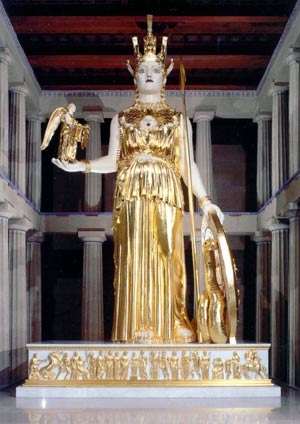 a slight increase towards the center: otherwise it seems from far away that the floor sags. Two middle corner columns are tilted to the middle - to the corners: this is done deliberately in order to make them seem perfectly straight. a slight increase towards the center: otherwise it seems from far away that the floor sags. Two middle corner columns are tilted to the middle - to the corners: this is done deliberately in order to make them seem perfectly straight.
All columns of the temple are equipped with entasis (entasis - from the Greek éntasis - tension): special thinning, which is a gradual change in the diameter of the column cross-section along the longitudinal axis from the maximum within the lower third of the trunk to a minimum at the end. Such technique allowed creating a visual effect of tension and, most importantly, eliminating an illusion of concavity of the column trunk.
The entablature (beam span or wall completion, consisting of architrave, frieze and cornice) of the temple is tilted outward, and the gables - inside. This element, however, rarely occurs outside the classical architecture. According to experts, the harmony of the temple consists of analogies, of repetition of the same proportions of both exterior colonnade and whole quadrangle and its internal colonnade. In this sense, the location of the temple with respect to the Acropolis hill also plays an important role. The Parthenon is located on the south-eastern edge of the cliff, and that is why the visitors of the temple see it a bit distant, which creates an illusion of gradual "emergence" of the temple, as you approach it...
The Statue of Athena
The cult statue of Athena, made by Phidias, is considered to be a sacred center of the temple Parthenon. The sculpture has not been preserved to the present day, and its appearance is known to us by the images that came to us in the form of coins. The 11-meter statue, according to numerous evidences, was made by chryselephantine technique - that is, it was made of ivory and gold on the base of wood. In one hand Athena held Nike, and with the other one she rested on a shield, representing a kind of "canvas", which showed amazonomachy.
Phidias portrayed himself on the shield in the image of Daedalus and Theseus. According to legend, he went to prison because of the perpetuation of his image and charge of stealing gold. However, that did not diminish his achievements as an artist. The shield of Athena is specific for its second and third grounds are not shown from behind, as usual, but one over the other. Another such relief image is performed on the sandals of the goddess, which shows centauromachy. The pedestal of the statue is decorated with a relief depicting the birth of Pandora - the first woman in Greek mythology...
Gothic: Dark Age or "intimidating grandeur"
(1).jpg) Speaking of the Gothic style, for some reason, first of all, I remember gloomy Hollywood movies about vampires and all evil spirits. Undoubtedly, the Middle Ages are one of the darkest and mystical periods of human history, filled with a great spiritual and religious enthusiasm. Just like other times, it was marked by a peculiar expression of human nature in various fields of art: literature, art, and architecture. Gothic architecture is a phenomenon that formed in Western Europe and partially Eastern Europe during the development of medieval art and took the time interval from 12 to 15-16 centuries. Speaking of the Gothic style, for some reason, first of all, I remember gloomy Hollywood movies about vampires and all evil spirits. Undoubtedly, the Middle Ages are one of the darkest and mystical periods of human history, filled with a great spiritual and religious enthusiasm. Just like other times, it was marked by a peculiar expression of human nature in various fields of art: literature, art, and architecture. Gothic architecture is a phenomenon that formed in Western Europe and partially Eastern Europe during the development of medieval art and took the time interval from 12 to 15-16 centuries.
The Gothic style of architecture has replaced the Romanesque style, gradually replacing it with new elements. That architecture was called "intimidating grandeur." Such name came from the fact that Gothic structures differed from the earlier Romanesque buildings by their huge sizes and phantasmagoric bas-reliefs, inspiring religious awe. Such design of Gothic buildings mainly came from the religious orientation of buildings.
Gothic was born in the mid-12th century in northern France, and in the 13th century was more widespread on the territories of modern Czech Republic, Austria, Spain, England and Germany. Italian Gothic stands on this list a bit aloof, because gothic penetrated into Italy a little later than in other countries, thus leaving in the history of Gothic style the name "Italian Gothic". And despite this, the word "gothic" has Italian origin: “Gotico” literally means "barbarian" from the word “Goten” - barbarians. This style has nothing to do with the historical Goths though.
At first, the word was used as an oath, but the word "Gothic" was first used as a term by Giorgio Vasari, who named it to clearly distinguish the Renaissance from the Middle Ages. In the end, Gothic became the final stage of European medieval art. Gothic architecture had a cult purpose and religious themes. Art of that age, including architecture, refer to eternity, divine forces and Christian worldview.
In the world architecture, gothic was reflected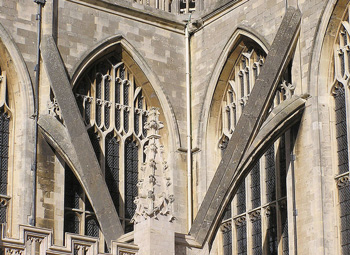 most clearly. Basically, it was typical for temples, churches, monasteries and cathedrals. Gothic architecture was based on the Romanesque or rather Burgundian style. Round arches, massive walls and small windows of the Romanesque style are replaced by typical Gothic arches with pointed tops, narrow and tall columns and towers, and decorated facade with carved details, which are called cymbals, archivolts and vimpergi. The distinctive features were lancet stained glasses and vertical, which emphasizes all the elements of style. most clearly. Basically, it was typical for temples, churches, monasteries and cathedrals. Gothic architecture was based on the Romanesque or rather Burgundian style. Round arches, massive walls and small windows of the Romanesque style are replaced by typical Gothic arches with pointed tops, narrow and tall columns and towers, and decorated facade with carved details, which are called cymbals, archivolts and vimpergi. The distinctive features were lancet stained glasses and vertical, which emphasizes all the elements of style.
Usually the Romanesque cathedrals and churches had cylindrical arches, resting on massive thick walls. That had several disadvantages: such structure inevitably led to contraction of building volume and, besides, created additional difficulties at construction, which, among other things, were the reason of a small number of windows and their small size.
However, the appearance of cross arches, system of columns, counterfort and flying buttresses changed the huge cathedrals into fantastic openwork structures of majestic look and enormous size, which inspired religious awe and admiration.
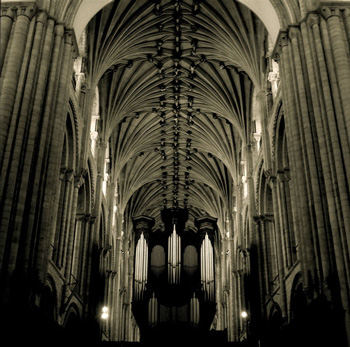 The main achievement of the architects of the Gothic period was a special system of counterfort and flying buttresses, which allowed distributing the load on the carrier of the buildings, thus increasing volume and size of the buildings under construction, which became symbols of their era. The main achievement of the architects of the Gothic period was a special system of counterfort and flying buttresses, which allowed distributing the load on the carrier of the buildings, thus increasing volume and size of the buildings under construction, which became symbols of their era.
Counterfort, from the French “contre force” - opposing force – are elements of architecture, widely spread in the Middle Ages, and elements of the Romanesque architecture. In fact, counterfort was a vertical structure, representing a protruding part of the wall, vertical edge, or a separate support connected with the flying buttresses wall. Typically, counterfort was erected around the entire building as a pier, which adhered to the walls on the outside, against those places, where the spring-loaded arches rested on.
In the era of Gothic, counterfort became important: the architecture of that period was characterized by high walls with a rather low bearing capacity, which was caused by large window openings cut in them. That is why counterfort became not only decorative, but also(1).jpg) very practical. At first, they were erected in Romanesque buildings - close to the wall. But with the development of Gothic style they began erecting counterfort at some distance from the wall, and even connecting with the flying buttresses. After a little more time counterfort got polygonal shape, and the surface of the building became more decorated, matching the general ornamentation of the building surface. very practical. At first, they were erected in Romanesque buildings - close to the wall. But with the development of Gothic style they began erecting counterfort at some distance from the wall, and even connecting with the flying buttresses. After a little more time counterfort got polygonal shape, and the surface of the building became more decorated, matching the general ornamentation of the building surface.
Flying buttress is one of counterfort types used in church architecture in the form of outdoor semi-arch. Its main purpose was transferring the horizontal thrust from arches to support pole. The use of this element allowed the architects significantly reducing the sizes of internal supports and freeing the building space, thus increasing the window openings and arch spans. The main purpose of flying buttresses was distribution of load as well as implementation of a decorative element.
So, counterforts and flying buttresses have become features of Gothic architecture. The basic principle of these elements was facilitating the loading of the general construction through redistribution of loads, thus turning the walls into a simple lightweight shell, the thickness of which did not affect the overall carrying capacity of the building anymore. That enabled the architects to make many windows in their buildings. In the absence of walls in Gothic architecture they began to develop the art of stained-glass and sculpture.
Among other things, in Gothic architecture they used a lancet form in arches, thereby reducing the side spacers that allowed directing a large part of the thrust to the support. The pointed arches of Gothic architecture gradually become more elongated and sharp, expressing the basic idea of Gothic architecture – up-directed temples...
***
But let's transport ourselves for a moment from the Dark Ages to the present, where we still feel the influence of "intimidating" style. Of course, you’ve guessed that we will speak about watches, and to be honest, about Gothic clocks or wristwatches, the design of which is clearly echoes the architecture of Gothic era:
Gothic watch “Agonium” from Daniel Strom
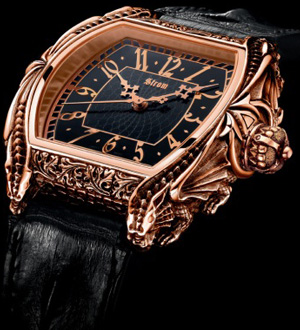 Medieval Gothic was not only Medieval Gothic was not only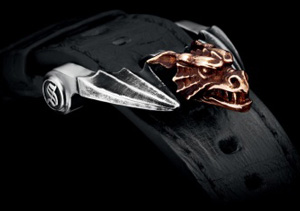 an inspiration to the watch companies, creating "Gothic" collections. This style has become a source of inspiration for the creation of numerous accessories, furnishings, clothing lines, and, of course, the watch industry simply could not stay away from the "Gothic excitement." The collection of watches “Agonium” from designer Daniel Strom is a vivid example of Gothic style in watches. an inspiration to the watch companies, creating "Gothic" collections. This style has become a source of inspiration for the creation of numerous accessories, furnishings, clothing lines, and, of course, the watch industry simply could not stay away from the "Gothic excitement." The collection of watches “Agonium” from designer Daniel Strom is a vivid example of Gothic style in watches.
A special philosophy and gloomy design have become features of Agonium watches, which include several models. One of them – the watch “Memento Mori, Carpe Diem”, inspired by the well-known Italian saying, which means "remember of death and enjoy the moment."
The creator of "watch Gothic" is Daniel Strom, son of famous Armin Strom. He created a number of various Gothic watches - the collection “Agonium”, the cases of which as if duplicate the phantasmagoric and gloomy counterforts and flying buttresses of Gothic cathedrals. The watches “Memento Mori, Carpe Diem” and “Draco” are the most remarkable ones.
“Memento Mori, Carpe Diem” has become a kind of message to the fans, who are called by the original designer to enjoy every moment of their life. The cases are decorated with skulls, making watches gloomy and solemn. The watches come in several variations, differing from each other by used materials: gold, platinum, palladium and silver. The watches are based on the self-winding movement ETA 2824, the water resistance of watches - 50 meters.
The next model in the collection “Agonium” is the steel watch “Draco”, devoted, according to its name, to the dragons. The designer has put the dragon’s head on the strap, and the case is made of precious metals according to the choice of fans: silver, gold, palladium and platinum. The figure of mythical dragon adorns the sides of the case and buckle of the strap. These watches are made by order, and the buyer chooses material of the case, color of the dial (black or ivory). The Gothic accessory is based on the same automatic movement - ETA 2824. The watches are released in a limited series of 44 and 88 copies. Of course, not only a gloomy era of Gothic, but also Gothic architecture with its majestic buildings, which are reflected in the brand’s wristwatches, have become an inspiration for making such watches. And, returning to the architecture, I think the most famous Gothic buildings should be noted...
 One of the most famous One of the most famous3.jpg) examples of Gothic architecture is Notre Dame, which is located literally in the heart of Paris, in its eastern part at the place of the first Christian church - St. Stephen's Basilica, which was once built at the place of the Gallo-Roman temple of Jupiter. examples of Gothic architecture is Notre Dame, which is located literally in the heart of Paris, in its eastern part at the place of the first Christian church - St. Stephen's Basilica, which was once built at the place of the Gallo-Roman temple of Jupiter.
The cathedral is characterized by duality of architectural styles: on the one hand, there is an influence of the Romanesque style, but on the other hand, the cathedral is a vivid example of Gothic style.
Innovative achievements of architects of this era appear in "lightness" and simplicity of the overall design of the building, despite the fact that the building’s height is 35 meters, length - 130 meters, and width – 48 meters.
Notre Dame de Reims is also one of the most famous Gothic cathedrals. It is built later than Notre Dame de Paris, in the 12th century. This cathedral is one of the most striking examples of French Gothic architecture, famous for its sculptures. Starting from the Middle Ages until the 19th century, the cathedral was the coronation place of almost all French monarchs, and now Notre Dame de Reims is in the UNESCO World Heritage List.
And, of course, speaking of the Gothic style, it is impossible not to mention the Czech Republic and its famous capital, which has become a unique "reserve" of architectural examples of different eras. However, no one style has left in this city such a bright trail as Gothic. In this sense, Prague became the "capital" of Gothic style. One of the most famous buildings of late Gothic period is St. Vitus Cathedral, located on the territory of the Prague Castle on the left bank of Vltava and the Charles Bridge - the oldest Prague bridge and one of the most beautiful Gothic constructions, connecting the Old Town and Lesser Town...
***
Corum: Ti-Bridge from the collection “Golden Bridge”
Gothic "vertical"
 In our discussion of the cult and its various manifestations we have gone a bit away from the topic of cult watches, referring to the cult buildings of Gothic period and reflection of that style in modern watchmaking. Let me introduce one more company that has "Gothic watch" - the company “Corum” and “Ti-Bridge” watch from the collection “Golden Bridge”. This model can be safely called an embodiment of Gothic "vertical", so specific for Gothic buildings. Of course, Ti-Bridge is not a cult model, however, it is still worth of being mentioned as an outstanding example of reflection of Gothic period and cult cathedrals that have become living witnesses of the Middle Ages. In our discussion of the cult and its various manifestations we have gone a bit away from the topic of cult watches, referring to the cult buildings of Gothic period and reflection of that style in modern watchmaking. Let me introduce one more company that has "Gothic watch" - the company “Corum” and “Ti-Bridge” watch from the collection “Golden Bridge”. This model can be safely called an embodiment of Gothic "vertical", so specific for Gothic buildings. Of course, Ti-Bridge is not a cult model, however, it is still worth of being mentioned as an outstanding example of reflection of Gothic period and cult cathedrals that have become living witnesses of the Middle Ages.
The expression "watch in Gothic style" sounds like a clever oxymoron, as judged from the standpoint that wrist watches simply did not exist in the era of Gothic. But a little later, in the era of romanticism, the influence of gothic "decor" begins to appear in different articles made by man. Horlogerie is one of the manifestations of this influence.
So, pocket watches with insets of stained glass, with carved folds in Gothic spirit, with enamel pictures, mostly of biblical or knight scenes, have become popular. Those plots, which decorated pocket watch dials, were quite popular in the era of romanticism. In a series of incredible daring technical and design achievements, the watch of Corum from the collection “Golden Bridge” looks a bit more surprising than watches from other collections. Today, the watch from this collection is one of rare models, which can be called "Gothic watch." The collection “Golden Bridge” from Corum was first introduced in 1987, and after resounding success the company traditionally started to please its fans with various models almost every year. By the way, it should be noted that the classic design of watches from the collection “Golden Bridge” has changed a bit and was supplemented with new components during its existence.
For example, the series “Golden Bridge Artisan Timepieces” includes three models with dials with tiny picturesque images. These models are “Adam & Eve” with a miniature copy of Dürer's painting, “Napoleon” with an image of Napoleon's army soldiers, and “Mucha” with a skillful depicted poster by Alphonse Mucha.
The watch from collection “Golden Bridge” of line “Full Pave”, incrusted with precious stones, diamonds, blue sapphires, rubies on the back cases, can be noted as another variation in this collection. The watch “Golden Bridge”, among other things, is produced with a massive bracelet made of gold, of various colors, which replaced the classic version of black leather strap. In 2000, the collection was completed with a "million" model – “Golden Bridge Haute Joaillerie Diamonds” with a diamond case and bracelet of white gold, decorated with baguette-cut diamonds. Despite the fact that on the background of brilliant splendor the main "advantage" of this watch, its unique movement CO-GB001, is a bit unnoticed, the watch has still won connoisseurs’ delight. Within the collection “Golden Bridge” they also released a women's watch, occupying a special place in the line.
But let’s get back to the Gothic. The men's watch “Ti-Bridge”, released in 2009, is one of the cult models of this series. The main technical feature of watch is the in-house caliber CO-GB001 of baguette shape, decorated with engraving. The caliber “Golden Bridge”, connecting the opposite sides of the rectangular case, got its name due to the bridge-like shape and location.
The model “Ti-Bridge” of 2009 is a golden "frame", transparent from all sides. This case, like a storefront, draws attention to the unique decoration of the watch: a narrow gold engraved movement, which is visible from all sides. The power reserve is 40 hours. The watch case is made of PVD-coated titanium. Unlike all other models of the collection, the model “Ti-Bridge” is designed in modern hi-tech style, but the black case, beautifully contrasting with golden caliber, gives the watch a "heavy" Gothic tone. The watch “Ti-Bridge” is released in a limited edition of 250 copies, also in an additional series of 138 copies. The watch is made in classic style of “Golden Bridge” collection, which is specific for PVD coating of titanium case. The watch “Ti-Bridge” is made in the classical linear form of the collection.
Shroud of Turin:
 One of the most famous cult Christian relics is the Shroud of Christ, or as they call it in another way - the Shroud of Turin. The story of its appearance and numerous studies relating to its origin and authenticity is one of the most interesting and exciting stories of the object, which is one of the most important cults of the Christian world. One of the most famous cult Christian relics is the Shroud of Christ, or as they call it in another way - the Shroud of Turin. The story of its appearance and numerous studies relating to its origin and authenticity is one of the most interesting and exciting stories of the object, which is one of the most important cults of the Christian world.
The Shroud is a large canvas of 4.3-meter length and 1.1-meter width. Today it is kept in the cathedral of the Italian town of Turin, on behalf of which it got its name - Sindone di Torino.
On a yellowish-white canvas you can see brown fuzzy spots, which from a distance resemble the outlines of human body: a man's face with beard and long hair. According to legend, that fabric covered the body of Jesus Christ during his funeral.
The image of the man imprinted on the shroud is pale but, according to eyewitnesses, quite detailed. They say that even with the naked eye one can discern facial features, beard, hair, lips and fingers on the canvas. In addition to prints of the human body, on the canvas you can also see traces of blood and many wounds covering the body.
According to the Gospel narrative, the image appeared, when the crucified body of Christ was laid in the burial cave. The body was lying on one half of the shroud, and the other half, thrown over his head, covered him from above.
The place where the shroud appeared in fact is unknown. There are numerous versions, theories, and assumptions, each of which confirms quite convincingly or refutes the authenticity of the Shroud origin by many modern research.
As for the history of Shroud, there are several versions. For example, according to traditions of Orthodox Church, the Shroud was kept in Constantinople, in the church of St. Sophia, and exhibited for worship during the Holy Week during the XI-XII centuries. There is also a written evidence on the Shroud from Nicholas Mazarita, who saved the Holy Shroud during the mutiny of the Imperial Guard in 1201 from fire, "Burial Robe of the Lord. They are from the blade and still fragrant anointing"...
Another written document, which has been preserved to our days, is an evidence of the Fourth Crusade chronicler Robert de Clary, who writes about disappearance of the Shroud from Constantinople in 1204 during destruction of the city. According to this version, the Shroud, as well as other stolen relics, was taken by the Crusaders of Western Europe. After that there were no evidences on it during 50 years! Many scholars and historians not without reason believe that all that time the Shroud was kept by the Templars, representing the Christian paramilitary Order, founded in the 12th century. Some sources also indicate that the Templars worshiped a mysterious head with a red beard. And considering that the image on the Shroud has a color of burn, which could have been left by iron on a white tablecloth, we can say about the color of image as yellowish-brown or… reddish. During.jpg) the persecution of the Templars the “head” disappeared. In 1951 in England during the restoration of historic building owned by the Templars, they found a board with the picture of this mysterious "red head" under the plaster on the ceiling, very reminiscent of the Shroud image... the persecution of the Templars the “head” disappeared. In 1951 in England during the restoration of historic building owned by the Templars, they found a board with the picture of this mysterious "red head" under the plaster on the ceiling, very reminiscent of the Shroud image...
By the way, the researcher Dr. Ian Wilson turned his attention to an interesting coincidence: the founder of the crusade related to the head of the crusade, which we’ve mentioned above. The head of the Knights Templar of Normandy (who was executed during the persecution of the Order by the French King Philip the Fair in 1314), in his turn, had the same name as the first holder of the Shroud - Count Geoffrey de Charny. As to the specific historical facts that have come to us, the history of the Shroud of Turin can be observed clearly only from the 14th century. It first appeared at that time, finding itself mysteriously in France in Lear at the Count Geoffrey de Charny, who in 1353 publicly announced that he had the Shroud, and he handed it to the local parish. However, at that time a small scandal erupted with the local bishop, who was against the public display of the Shroud. Besides, as it turned out, Geoffrey could not give an intelligible explanation of its origin and how it appeared at him.
35 years later, in 1389, the son of Geoffrey de Charny enlisted the support of the Pope and organized a second attempt to put out the Shroud in the temple. At that time the relic was placed in a specially built church in Lira, in the realm of de Charny. But that time, the relic raised protest from the church again. Thus, the local bishop Pierre d'Arcy, officially declaring the Shroud a work by an unknown artist, opposed that.
He issued a special memorandum on that subject, in which he set out his concerns about the origin of the Shroud. This memorandum is also one of the first written documents about the Shroud, which the historians have.
The debate on the Shroud continued to escalate until Pope Clement VII pronounced his verdict: to show the Shroud in the church, but only on the condition that they would explain that it was not a real canvas, in which the Lord’s body was wrapped by Joseph of Arimathea, but an art reproduction - icon.
After that, the Shroud, however, was still "traveling". In 1452, Marguerite de Charnay - the granddaughter of Count Geoffrey sold the Shroud to the Duke of Savoy, who subsequently stored it in the cathedral of the French city Chambery, where the Shroud was kept before going to Turin. In Turin the Shroud was kept beginning from 1578 in a special ark at the Cathedral by Giovanni Batista, and since 1578 its fate was known by months... First scientific interest in the Shroud broke out in the late 19th century. It all began with an international exhibition of religious art in Paris, which was held in 1898. Then, the Shroud was presented to the public, however, not as a cult relic, but as a badly preserved creation of early Christian artists.
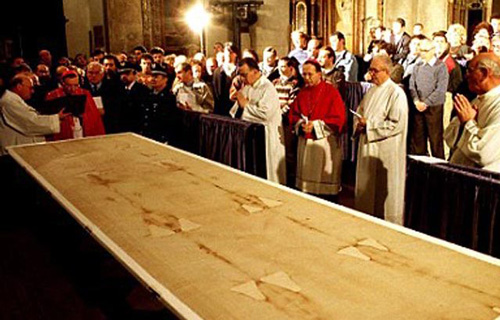 In May, 28, at the height of the exhibition, Secondo Pia, an amateur photographer, took a picture of the painting: the Shroud was placed high above the arch, where the exhibition took place. One of two pictures was bad, but the second one became a real sensation: on the dark background of the negative a positive photographic portrait of Christ was discovered. The photographer, who unexpectedly made a startling discovery, told in his interview that the night, when a positive image of Jesus Christ started developing on his photographic plate, his excitement knew no bounds. In May, 28, at the height of the exhibition, Secondo Pia, an amateur photographer, took a picture of the painting: the Shroud was placed high above the arch, where the exhibition took place. One of two pictures was bad, but the second one became a real sensation: on the dark background of the negative a positive photographic portrait of Christ was discovered. The photographer, who unexpectedly made a startling discovery, told in his interview that the night, when a positive image of Jesus Christ started developing on his photographic plate, his excitement knew no bounds.
It seemed the sensational discovery of Secondo should have entailed extensive research of the painting. But the church did not allow scientists to approach the canvas, which was then carefully guarded. And so the first researches relating to the canvas are a study of the Shroud on the basis of better quality pictures. With their help, the researchers were able to identify some important details. For example, in 1902 the French biologist Paul Vignon managed to examine the anatomy of the man depicted on the canvas. In 1931, new photos of higher quality became a proof that the image on the canvas belonged, according to ethnologists, to the person relating to the natural type of Sephardic Jews. According to the researchers, his height was about 178 cm, and the age – about 30-45 years.
The second stage of researches of the Shroud was in 1969-1973. For the first time the scientists were admitted to the direct study of the Shroud in 1969. A group of 11 professionals who were allowed to work with the canvas, was created. However, the first "meeting" of specialists and canvas had a goal not to research, but preserve. The main question was about its future storage. However, some time later the studies of canvas were continued again. At that time, a scientific research took place in 1973. One of the researchers was a Swedish criminologist Max Frei...
The modern cults: an ode to the material values
Well, we can say that we could find out for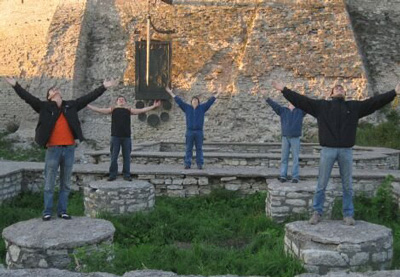 ourselves at least a little what a cult is and how it manifests itself not only in our understanding and consciousness, but also how it materializes in human culture, his system of values, as well as in various subjects, which have the status of "cult." ourselves at least a little what a cult is and how it manifests itself not only in our understanding and consciousness, but also how it materializes in human culture, his system of values, as well as in various subjects, which have the status of "cult."
According to dictionaries and different definitions, cult is a religious worship of any creatures or objects. However, the problem of determining these most "cult" phenomena and objects, which we’ve talked about (and which we have not mentioned), is quite difficult due to the fact that the term itself over time as if has been "obliterated" because of frequent abuse by extending the meaning and "washing out" a certain definition...
Whatever it was, we’ve tried to define "cult" objects and phenomena on the basis of novelty and "radical" effect on human culture and stereotypes... You may say that veneration and worship were left in the distant past and specific only to our ancestors, and the modern man is less dependent on worship. Let us prove the opposite. Today we are surrounded by a fairly large number of phenomena, which we call cult because of the above mentioned and other reasons.
Modern cults present in art and material values of the 20-21 centuries. Cult movie, cult directors who create this movie, cult singers and actors, cult artists - each of them has created something new, opened a new world, causing a feeling of worship and thus becoming a cult concept for us. As for the religious objects, modern cults, in fact, differ little from those of subjects, which the human story brought us. Each of them is something new and striking to human consciousness...
One of the main differences of the 21st century from other eras is that luxuries have become to be considered cult. Luxury items - cars, jewelry, various technical products - all this has become cult, even mundane. Watch, as one of the most necessary and status accessories of the 21st century, hasn’t escaped the "cult" fate either. The concept of "cult watch" has quietly come in our lives, and it's hard to determine when and what brand was the first manufacturer of "cult watch". However, that did not become an obstacle to the concept of "cult watch" spread not only among avid collectors and enthusiastic experts, but simply those, who are interested in the world of watchmaking. But before we start talking about cult watches, to which our article is devoted, let us talk a little about modern cults...
The cult movies
The concept "cult movie", meaning admiration and cult reverence, lasted more than a decade among movie fans. This is expressed not just in a regular movie watching, but also in creation of a subculture (in some very extreme cases - religion), based on the fictional world of movie. For example, the fiction saga "Star Wars", conceived by U.S. director George Lucas and first appeared on big screens in 1977, became such movie. That movie had an enormous impact on the international pop culture of that time and was repeatedly recognized as one of the best science fiction movies of all times. The cult component of a movie is not determined by commercial success, which popular mainstream pictures can boast of, but by its influence on cinema. In this regard, "Star Wars" with its deafening commercial success is more likely to be an exception.
There are, of course, some difficulties with the definition of "cult" movie. The problem is that the more often and wider the term is used, the "emptier" its specific meaning gets. Today this concept is shamelessly used by many film distributors as a marketing trick that assigns the title of "cult" to various movies, which can be practically named "dumping" goods... A cult movie de facto is determined by that special reaction of people, which is created around a particular movie, and often from a whole unit some fragments come to life, which then become elements of pop culture. Thus, such phenomena in the history of cinema are movies of the 80th - "The Blues Brothers" and "Rocky Horror Picture Show," which over time have become classics of cult movies. Ultimately, cult movie, as a rule,  opens a new milestone in the history of cinema and qualitatively differs from the previous movies, seamlessly fitting into the overall period. The main quality of a cult movie can be called a "breakthrough" it produced in its time... opens a new milestone in the history of cinema and qualitatively differs from the previous movies, seamlessly fitting into the overall period. The main quality of a cult movie can be called a "breakthrough" it produced in its time...
***
The eccentric comedy by Billy Wilder “Some Like It Hot”, based on a story by Robert Thoeren and Michael Logan and received wide recognition and awards such as Oscar and Golden Globe, becomes a cult comedy of the 50s. Jack Lemmon, Tony Curtis and Marilyn Monroe played the key roles. The last sentence of the movie became one of the most quoted phrases in the history of cinema. During the final scene, when millionaire Osgood discusses with the girl Daphne (who is actually musician Jerry) the nuances of the upcoming wedding - "she" is trying to escape, giving arguments of smoking, infertility, and imperfect behavior, but Osgood is ready to accept and forgive everything. The musician has to open up and say at a low baritone that he is a man! Then the millionaire calmly replied: “Nobody's perfect”.
The famous gangster drama “The Godfather”, recognized by the American Film Institute as the best gangster movie, can also enter the category of cult movies. The slogan, which runs along its line of the movie's plot: "Real power can’t be given. It must be taken...".
In the 90's one of the cult movies was the picture by Quentin Tarantino "Pulp Fiction", which became specific for the best parts of the dialogues, included in the soundtrack of the movie...
The cult books
Well, the definition of "cult book" is as difficult as the "cult movie." You can define a cult book in many ways, separating them by various criteria: genre, era features, novelty of presentation, etc. The criteria, by which a book can be attributed to the category of cult books, can be listed endlessly. And, of course, none of the characteristics will be able to give a complete description of "cult book." A cult book is different from an acclaimed bestseller, popular and well-known books by a kind of barely perceptible nuance. Thus, the Darwin's book "The Origin of Species" presents radically new views, but it can be hardly called a cult one, but at the same time "Thus Spoke Zarathustra" by Nietzsche is considered to be one of the most cult books of all times...
The cult cars
Big money is a certain status and obligations: it is the modern world. And it almost always was like that. A king should live only in the palace, a real lady will not eat canned fruits, and modern "kings" will cherish above all their status, which is emphasized by a particular category of material things. Today, material values can be called the cult of modern life. Everybody wants a good life, big money, and possession of expensive and exclusive things that emphasize lifestyle and commitment to a particular social circle. The car became one of those indicators, which we’ve mentioned just above. And among them there is a concept of cult too: this is cars that became a new word in engineering...
Maybach
This car says that its owner has reached the highest position in society, proudly displays it, and, of course, cares about its reputation: for its business trips it uses the best luxury sedan in the world. The brand “Maybach” initially shone at the beginning of the last century. In the 30s of the 20th century, its production stopped, and only 60 years later Maybach again resumed production of the cult car that was a conceived commercial move: the marketing group of Daimler Chrysler decided to design a car that would have surpassed Mercedes S500 AMG and become a new symbol of elite car. The manufacturers have achieved this goal - the car Maybach has not become just a luxury car, but a new word in the category of elite cars. Maybach has become a new cult of the new millennium, a cult of luxury and power. Today, the manufacturer produces two models of luxury car - Maybach 57 of 5.73-meter length and Maybach 62 of 6.17-meter length. The price on the cars makes up 310 and 360 thousand euros respectively.

Mercedes-Benz
One of the most cult companies producing cars is the company “Mercedes-Benz”. Today it has become the leader in the manufacture of automobiles. However, Mercedes S500 AMG, which has become one of the most famous cult cars of luxury class, can be referred to cult models.
Today, the Mercedes models of S-Class are the most popular in the world, clearly evidenced by the company's sales. For example, in 2006, the world sales of these cars reach 91,800 thousand, and in 2007, S-Class expands through four new all-wheel drive versions of 4Matic: S 320 CDI, S 350, S 450 and S 500.
The S-Class cars have become a classic business style, which at the same time represent the latest technological advances. The only drawback (if it, of course, can be called a drawback) is that the cars of this series become almost massive cars in the circle of businessmen immediately after their release.
Audi
The company “Audi” is a world-famous car manufacturing company today, the products of which can be classified as cult in good conscience. The start of the company’s history wasn’t unclouded: in 1910, the court considered the case of August Horch charge by his former colleagues from the company “Horch”. The differences between August and his colleagues, which made August leave his own firm, founded by him in 1899, led them to the court. After that August opened a new firm with the same name, and the existence of two firms with the same name led to protests from former colleagues of August and resulted in litigation. By the verdict of the court, the second company was given the name “Audi”, which in German literally meant the translation of the surname “Horch” – “to listen.” After the war, the city, where the company “Audi” was located, Zwickau, became a part of the GDR, and they nationalized the manufactory “Audi”, producing cars of different brands. After a temporary absence at the market Audi returned in 1965, presenting the front-engine Audi 1700 with a very economical engine designed by Daimler Benz at the Frankfurt Motor Show. The four-wheel drive versions “Quattro”, which gained success repeatedly on various international rallies, brought the company a high authority at the car market. The release is initiated by a gifted engineer Ferdinand Piech...
The cult music
How can one determine what kind of music is cult? Classics, because it laid the foundations of harmony? Rock music, which became a particular subculture and gave rise to phenomena, such as hippies, punks, metallers, goths? Or jazz, which emerged in the late 19th century as a result of mixing African and European music, which changed the traditional rhythmic pattern of music that existed before?
***
It seems that finally it's time to talk about cult watches. About chronometers, which became a new word in the world of watchmaking at their time. The XX century became a remarkable era of discoveries and designs in the history of watchmaking. In a short period of time - about 200 years - the world of watches has experienced an amazing and dynamic evolution, which left us wonderful products, as an example of human thoughts flight, his imagination and perseverance to achieve his goal.
So, the cult watches...
To be continued...
|


